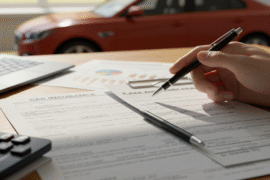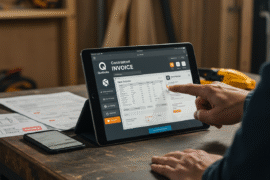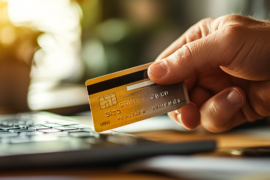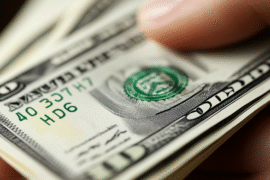This article may contain references to products or services from one or more of our advertisers or partners. We may receive compensation when you click on links to those products or services. Nonetheless, our opinions are our own.
The information presented in this article is accurate to the best of our knowledge at the time of publication. However, information is subject to change, and no guarantees are made about the continued accuracy or completeness of this content after its publication date.
Have you ever been in a tough spot where you weren’t sure if your savings could cover an unexpected cost? You’re not the only one. A lot of people want to know if it’s possible to overdraw a savings account, what the effects might be, and how it could change their financial situation. We’ll talk about the facts about overdrawing a savings account, answer common questions, and clear up any confusion. By the end, you’ll know how your savings account works and what to do if you don’t have enough money.
- Understanding the Basics of Overdrafting Your Savings
- The Dangers of Overdrafting and How to Stay Safe
- Finding Alternatives to Overdrafting
- Tips for Managing Your Savings and Preventing Overdrafts
- When to Consider Setting Up Overdraft Protection
- Take Control of Your Finances with Smart Saving Tips
- Understanding Your Overdraft Options
- Overdraft Protection Details
- Additional Tips to Avoid Overdraft Fees
- Conclusion
- Frequently Asked Questions
- Recommended Reads
Understanding the Basics of Overdrafting Your Savings
When managing a savings account, it’s important to understand how overdrafting works. Although overdrafts are typically associated with checking accounts, some savings accounts may allow them under certain conditions. Keep these key points in mind:
- Overdraft Security: Some banks offer services that allow you to spend beyond your balance, up to a specific limit. However, these services often involve fees or interest.
- Account Rules: Review your account’s terms. Not all banks permit overdrafts on savings accounts, and policies vary.
- Effect on Savings: Relying heavily on overdrafts can undermine your savings goals. Every withdrawal may carry fees that outweigh the benefits of accessing extra funds.
Overdrafting might seem like an easy fix, but it’s essential to consider both the pros and cons. If you often need to overdraft your savings, it may be time to reevaluate your budget and explore better financial strategies.
The Dangers of Overdrafting and How to Stay Safe
Overdrawing from your savings comes with risks. You may incur high fees that quickly drain your balance. Banks typically charge fees for each instance of exceeding your available funds, which can lead to a difficult financial cycle. Moreover, relying too much on overdraft options can encourage overspending and weaken your budgeting discipline.
To stay protected, consider these practical steps:
- Check your account balance regularly to avoid unexpected overdrafts.
- Set up low balance alerts so you’re warned before your funds run out.
- Create and follow a basic budget that leaves room for adjustments.
- Link your savings account to your checking account for automatic transfers, helping cover shortfalls without added fees.
Being proactive about your finances improves your savings strategy and helps you avoid overdraft issues altogether.
Finding Alternatives to Overdrafting
Overdrawing a savings account may feel like a quick fix in emergencies, but it can lead to fees and financial setbacks. Instead, consider these alternatives to maintain financial stability without risking your savings:
- Create an Emergency Fund: Save three to six months’ worth of expenses to handle unexpected costs.
- Use a Budget: Track your spending to identify areas where you can cut back and increase savings.
- Build a Side Income: Consider freelance work, gig jobs, or other ways to earn extra money without relying on overdrafts.
A detailed financial plan can help you understand your spending habits. Use tools or spreadsheets to track categories like:
| Expense Category | Monthly Budget | Actual Spending |
|---|---|---|
| Housing | $1,000 | $1,050 |
| Utilities | $200 | $180 |
| Food | $300 | $350 |
| Transportation | $150 | $120 |
| Entertainment | $100 | $90 |
This approach helps you spot overspending and set realistic savings goals. With consistent habits, you can protect your savings and improve your overall financial health.
Tips for Managing Your Savings and Preventing Overdrafts
Managing your savings account carefully helps you avoid overdrafts and feel more confident about your finances. Here are some easy ways to stay in control:
- Track Your Spending: Regularly review your account balance and transactions.
- Set Up Alerts: Most banks offer notifications for low balances or large withdrawals—activate these alerts.
- Create a Budget: Allocate funds for necessities, savings, and extra expenses to stay on track.
- Use Automatic Transfers: Schedule transfers to your savings account to build an emergency fund.
- Keep a Buffer: Maintain a small cushion in your account to cover unexpected costs and avoid overdraft fees.
If you often have low balances, review your spending habits. Here’s a sample budget:
| Expense Category | Monthly Budget |
|---|---|
| Housing | $1,200 |
| Groceries | $400 |
| Utilities | $300 |
| Transportation | $200 |
| Entertainment | $150 |
Using these strategies can help you manage your savings better and reduce the risk of costly overdraft fees.
Voted "Best Overall Budgeting App" by Forbes and WSJ
Monarch Money helps you budget, track spending, set goals, and plan your financial future—all in one app.
Get 50% OFF your first year with code MONARCHVIP
When to Consider Setting Up Overdraft Protection
Overdraft protection can be useful in certain situations. You might consider enrolling if:
- Frequent Overdrafts: You occasionally exceed your balance and want to avoid repeated fees.
- Automatic Payments: You have recurring bills or subscriptions that need to be processed, even if your balance dips.
- Minimal Savings: If your emergency savings are limited, overdraft protection offers some financial flexibility.
Take Control of Your Finances with Smart Saving Tips
It’s important to understand how your savings account functions, especially regarding overdrafts. Most savings accounts are meant to help you store money and earn interest—not to serve as overdraft tools. However, some banks offer overdraft protection for savings accounts to prevent declined transactions and penalties.
Considerations
- Fees: Overdraft protection may come with transaction or transfer charges.
- Interest Rates: Using overdraft protection could reduce the interest you earn since you’re withdrawing from your own savings.
- Spending Habits: Depending on overdrafts too often may lead to careless spending and diminished savings.
If your bank permits overdrawing from a savings account, you need to understand the potential costs:
| Type | Standard Fee | Potential Increase in Costs |
|---|---|---|
| Overdraft Fee | $35 | Multiple overdrafts can add up quickly |
| Interest Loss | N/A | Reduced interest if funds are withdrawn |
Not relying on overdrafts is the best way to get real financial stability in the long run. Instead, you should save money and plan wisely.
Understanding Your Overdraft Options
Some banks offer overdraft protection for savings accounts, but you must understand the costs and implications. Evaluating fees, overdraft limits, and how they affect interest can help you make informed decisions and reduce financial stress. You can avoid having to use overdraft features altogether if you have good money habits, like making a budget and setting financial goals.
Overdraft Protection Details
Overdraft protection is a service that links your savings account to another account, credit card, or line of credit. Rules vary by bank, so check with your institution to learn what options are available. Overdraft protection can provide peace of mind and help prevent declined transactions and large fees.
Additional Tips to Avoid Overdraft Fees
You can reduce the risk of overdraft fees by:
- Setting up automatic transfers between accounts
- Building an emergency fund
- Monitoring your spending regularly
These actions can help you avoid unnecessary charges and improve financial control.
Conclusion
Savings accounts are meant to help you build financial security, but it’s important to know the risks and limits, especially when it comes to overdrafting. Most savings accounts don’t let you take out more money than you have, and those that do usually charge high fees or pay less interest. If you often run out of money, it’s time to look over your budget, change how you spend your money, and build up your emergency fund.
Overdraft protection might help you out in the short term, but it should never take the place of good money management. You can avoid overdraft fees and improve your financial future by keeping track of your spending, setting up alerts, and looking into other options like budgeting tools or side jobs. In the end, being aware of your savings and taking action with them helps you stay in control, lower your stress, and be ready for unexpected money problems with confidence.
Frequently Asked Questions
What does it mean to overdraft a savings account?
Overdrafting a savings account means withdrawing more than your available balance. This results in a negative balance, and your bank may charge fees or interest depending on its policies.
Can you go past the limit on a savings account like with a checking account?
Most savings accounts do not allow you to spend more than you have. If you try, the transaction may be denied. However, some banks offer linked services to cover the shortfall by transferring funds from your checking account.
What happens if you go over the limit in a savings account?
If your savings account permits overdrafts, you may face fees for insufficient funds. Repeated overdrafts could affect your credit score or even lead to account closure.
Are there any banks that allow overdrafts on savings accounts?
Some online banks or credit unions may offer overdraft services or allow linked transfers. Always review your bank’s terms to understand your options.

Reviewed and edited by Albert Fang.
See a typo or want to suggest an edit/revision to the content? Use the contact us form to provide feedback.
At FangWallet, we value editorial integrity and open collaboration in curating quality content for readers to enjoy. Much appreciated for the assist.
Did you like our article and find it insightful? We encourage sharing the article link with family and friends to benefit as well - better yet, sharing on social media. Thank you for the support! 🍉
Article Title: Can You Overdraft a Savings Account? Avoid These Fees and Hidden Costs
https://fangwallet.com/2025/07/21/can-you-overdraft-a-savings-account-avoid-these-35-fees-and-hidden-costs/The FangWallet Promise
FangWallet is an editorially independent resource - founded on breaking down challenging financial concepts for anyone to understand since 2014. While we adhere to editorial integrity, note that this post may contain references to products from our partners.
The FangWallet promise is always to have your best interest in mind and be transparent and honest about the financial picture.
Become an Insider

Subscribe to get a free daily budget planner printable to help get your money on track!
Make passive money the right way. No spam.
Editorial Disclaimer: The editorial content on this page is not provided by any of the companies mentioned. The opinions expressed here are the author's alone.
The content of this website is for informational purposes only and does not represent investment advice, or an offer or solicitation to buy or sell any security, investment, or product. Investors are encouraged to do their own due diligence, and, if necessary, consult professional advising before making any investment decisions. Investing involves a high degree of risk, and financial losses may occur including the potential loss of principal.
Source Citation References:
+ Inspo
There are no additional citations or references to note for this article at this time.












































